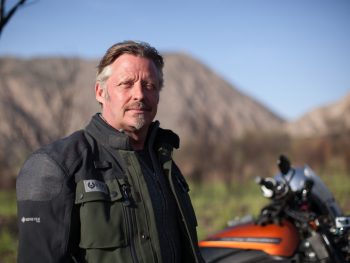Interview: GoWithFlow and Charley Boorman on the fleet switch to EVs
At this month’s Web Summit, sustainability mobility management firm GoWithFlow teamed up with actor and EV enthusiast Charley Boorman to run an electric vehicle master class for fleets.
Head of marketing Tomas Edwards, along with Charley, spoke to Natalie Middleton during the event about the practical applications and difficulties of electric vehicle adoption for operators and how they’re being solved.
It’s over a decade since the Web Summit annual tech conference was founded and this year’s event in Lisbon revealed more than ever how the solutions to many global challenges are out there – and the sheer level of innovation that exists.
Held earlier this month and described as the most important tech event in the world, it was a fitting platform for GoWithFlow to team up with actor, presenter and EV expert Charley Boorman to discuss practical applications of electric and hybrid vehicles and the challenges with charging.
Their master class drew on Boorman’s experiences when he reunited with actor and friend Ewan McGregor in 2019 to ride two prototype electric Harley Davidson motorcycles across the length of South America for the Long Way Up series, showing that electric vehicles can be made to work, even with much-limited charging infrastructure, and spotlighting that sustainable transportation is the future.
It’s a message that the GoWithFlow team is also passionate about.
Named Portugal’s top cleantech start-up in 2020 and officially founded in 2019 when Portuguese energy giant Galp acquired a majority stake, the firm actually has technology roots stretching back to 2010 when CEiiA (Portugal’s Center of Engineering and Product Development) participated in the MOBI.E municipal mobility programme and created the software which sits behind the country’s public infrastructure for charging.
That technology is now the basis of GoWithFlow’s Sustainable Mobility Management (SMM) platform, which helps enterprises – of all sizes – manage the transition of their fleet to low- or zero-emission vehicles while reducing overall fleet and energy costs. The solution provides an integrated view of vehicle and energy data, enabling fleet and facilities managers to plan and operate a network of combustion and electric vehicles along with managing fuel and electricity consumption.
The business now works across the globe to enable fleets to make the transition to electric vehicles as part of an holistic sustainable mobility focus.
Speaking to Fleet World during the Web Summit, head of marketing Tomas Edwards explained that its original work on the software for the Portuguese charging network – which is said to be the envy of the world – has put it in a unique position to be able to actively work with fleets and support them in this way, as an advocate of electrification.
“What we’ve done is turn our expertise and knowledge into some products and services that enable us to then help municipalities or businesses with fleets who want to transition to electric vehicles.
“We can provide them with the technology that enables them to connect drivers to vehicles to charge points so the company itself can monitor and control that whole process. They can see what’s being paid for what, how much charge is being used and where they’ve been with that charge. So you can create your own audit trail and, essentially, show that what’s being done by your fleet drivers is actually what you’ve requested them to do, along with all the payments and reporting on carbon output as a result of that.”
A case-by-case approach
What GoWithFlow has learned in that process is that many problems with going electric are universal – and that there are some companies where it’s just not practical to transition to electric vehicles yet.
Edwards continues: “There’s companies that contractually have to respond to events based around, say a burglar alarm, within a certain amount of time. And you can’t do that if your van hasn’t got electric charge in it.
“There are businesses who have sales reps, who of course want to maximise the time their reps spend with customers and they don’t want them to be spending time charging up vehicles on the side of the motorway or even at home or a restaurant. So how do you shift the working patterns of these people to move towards electric mobility when it’s a different culture? All of those problems we solve within our technology.”
Of course, working globally means that the company is used to dealing with very different electrification challenges and business backgrounds – and in some countries the process is at a more advanced stage than others.
Edwards explains: “What we find is that when a government mandates the transition – so in the UK, for example, in 2030 – that kind of creates a market for us.
“So then it’s just a case of the timing when we actually step into and say, “Actually we can support you with your transition journey.’
“And we’re not evangelistic about it; we aren’t telling everybody that they need to transition towards electric vehicles today; we very much understand that there’s a decision to be made over what vehicles can and can’t be transitioned because of the use case.
“So we have software that would analyse your behaviour as a fleet, and we would then report back to you and say essentially this proportion can be electric, but then in three years’ time when batteries and infrastructure change, then it will be the rest of them. But it’s important to remember that today, there are still very many use cases where diesel and petrol are still required; electric doesn’t solve everything.
“The other bit that’s interesting as well as is that when we look at it, we don’t just look at cars or vans, we’re looking actually at the future model of mobility. First of all, it does include hydrogen as well; we’re not just focused on electric vehicles, we think about sustainable mobility in its totality. So it includes hydrogen in the future.
“But we can map in e-bikes or e-scooters into that sort of mobility model as well. It doesn’t really matter what the asset is. Our system just recognises it as a vehicle of some kind. And even public transport we can map into this. So it’s a complete shift in the way that people consider their mobility as an organisation.”
An inclusive solution to range and charge anxiety

By linking the driver, the vehicle and the charging infrastructure, GoWithFlow can help eliminate range anxiety
By adopting an all-in-one approach that reports back not just on vehicle use but also charging, the business can also help eliminate range and charge anxiety. Even in vans, which have shorter ranges than cars.
“Where it becomes interesting again is that when you plug these assets into our network, you really start to understand the use case of the van,” Edwards continues. “So for instance, one of the really popular ones is the electric version of the Volkswagen Transporter, which only has a range of 82 miles. And I’m a marketeer. I don’t even have to worry about it because I’m pretty sure that Volkswagen did some research and found that the average Transporter driver doesn’t need to do more than 82 miles a day. Of course there are exceptional use cases when it does, but 95% of time, whatever the statistics might be, they will only need to do that.
“The problem is that consumer range anxiety exists for fleets as well, so they may think, “We can’t run that, it only does 82 miles,” And it does seem like a very short range. But if the Transporter is only being driven for 30 miles a day, why would you care? It doesn’t make any difference, right? So it’s all about that sort of knowledge and making sure that people understand this for the future, because once you understand the data and once you see it mapped out, you do not need to have a longer range than 82 miles, or whatever the stat might be for that particular use case. And that range anxiety disappears.”
GoWithFlow also has an app that’s used by fleet drivers when they’re on the road, helping them locate and reserve charging stations if they need to charge and even turn them on and off via their device. It’s backed by fleet data at the back-end to understand what’s been happening and how much the business is paying.
The technology also means that regardless of the level of charging infrastructure, the driver needn’t worry.
“Our technology can really enable that – because of course if it is linked to your schedule and it is linked to your route, then it will know exactly how much charge you need on any given day or any given week or any given month.
“And once you know that, then it can tell you actually that’s fine because you can charge it up on a Monday morning and on Wednesday night and on a Friday when you go to depot number three and it can plan all that for you and reserve it and it can tell you where you need to be.
“And at that point you don’t have to worry about the fact there’s no infrastructure on the side of the roads, because actually the car and the data will tell you that it’s all fine because it’s all been planned for you.
“It’s only data that can do that for you. And it’s only by linking the driver, the vehicle and the charging infrastructure.”
An ardent advocate for EVs

Actor Charley Boorman’s Long Way Up electric motorcycle journey with friend Ewan McGregor showcased just what’s possible with EVs, even with limited charging infrastructure
An insight into GoWithFlow’s background and work shows just how good a fit Charley Boorman is for its work; his Long Way Up electric motorcycle journey with McGregor was an epic adventure that showcased just what’s possible with EVs, even with limited charging infrastructure.
In fact, Boorman says the biggest thing with switching to EVs is the fear of the unknown.
He adds: “For sure when you get your first electric vehicle, it takes a little bit of time.
“But this idea of range anxiety is actually not new. It happened when people first started driving petrol cars. Back in the day, you could only buy petrol in a chemist – if they had it. So people had terrible range anxiety, you know.
“As Tomas says, people think you can’t go anywhere with EVs because they only do x amount of range. Well, Ewan and I did Long Way Up to prove that it can be done. And we did do it. We did 30,000 miles in 13 countries with no fast chargers, just plugging into people’s homes and plugging into their lives. And it was a great experience.
“People come up to me and say I can’t go anywhere with my electric car or motorbike and I say, ‘Well, I did.’ But I get it. And, you know, I think people are scared or afraid of change, so people are afraid of things they don’t understand. So it’s easier just to say, ‘I can’t do it.’ But how many people actually drive 300 miles a day? And even if you’re an Amazon delivery van driver, you’re not driving 300 miles a day. You’re riding your route, you know your route and you stick to your route so you know where all your chargers potentially.
“We’ve just got to manage the switch and, as Tomas says, it’s on its way. We don’t have a choice. So we can sit down and complain about or worry about range anxiety but it’s irrelevant because we have to do it.”
Boorman continues: “So coming here, and being able to share my experience with what GoWithFlow are doing, has been fantastic. And the plus side was to meet these amazing people; really intelligent, credible people at the summit and you get the feeling that someone at the Summit has got the answers for these huge problems that we have with the world. I’ve left feeling quite encouraged by the whole thing.”
And Tomas adds in: “Just to follow up, we were talking with someone last night about lunar mobility. So I wonder what that’s going to look like. And talking about transitioning in stages, when I pointed out there’s nothing on the moon and there’s no reason to go there, he said, ‘Well, yes, but if we can test it on the moon, then we can do the next stage on Mars.’ And they’re already working on how mobility works on an extra-terrestrial planet. So that’s pretty special.”
The next steps
While GoWithFlow’s business aspirations are more down-to-earth, it too is focused on expanding the markets it operates in, as it promotes its solutions work.
Commenting on future plans, Edwards explains: “We are at the moment dominant in Portugal, and behind the scenes actively operational in Latin America. We are down the road in the UK and Spain as well.
“And we’re now reacting to several significant opportunities that we have in North America.”
He continues: “What we need to do in particular, especially as we tackle the UK market, is start to be more vocal and actually explain who we work with and who we’ve helped.
“We tend to sit behind the scenes so people don’t know our brand name so well. But we will push that in the future.”
The business is already working in the UK with several of the big fleets, and it also has a relationship with Oracle, the data providers. “We’re working closely with them to look at their client base as well; as you’d imagine there’s a neat tie-in between the two organisations. The more vehicles and charge points that are linked to us, the more data we need. So we’re working with organisations like that to introduce ourselves to their client base.
“There’s another few partnerships and organisations with client bases where we’re introducing into their marketplace. So next year will be huge in the UK for us.”
GoWithFlow has also signed up for next year’s Web Summit and is looking to go on the main stage after this year’s talk was very heavily subscribed to – the queue for its master class was out of the door.
And as part of the firm’s education piece, Edwards and CEO Jane Hoffer also went to COP26, where Hoffer led a panel gender and decarbonisation.
Edwards also says GoWithFlow’s work is being supported by much-higher awareness now of the need to go green by companies; both in general and in terms of vehicle use.
“Most big organisations or SMEs have an eye on their impact now. They know it’s powerful from a brand perspective. They know that for their brand, because they’re part of the supply chain, then their clients want to see them doing this so they’re actually on the journey.
“But also when you’re going electric in a controlled manner, when you do it with the right data to show that the decisions you’ve made are correct, it’s actually cost beneficial as well. So running an electric vehicle is cheaper as an asset than running a combustion engine.”
He sums up: “So it’s a financial decision and one that’s great for the environment. And it’s being mandated by government. So it should be the easiest decision in the world, right? Because you can’t do anything else but transition.”



